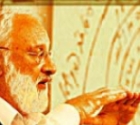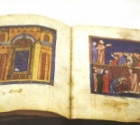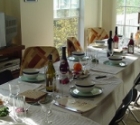
Going up to Jerusalem during Succot is an amazing experience. Succot, one of Judaism's three pilgrimage holidays, harks back to life in the Land of Israel in biblical times. During First and Second Temple times, Jewish pilgrims came to Jerusalem to make thanksgiving offerings to God, ranging from doves to livestock. To get an idea of what Jerusalem was like in those days, I recommend a trip to the Davidson Exhibition and Virtual Reconstruction Center in Jerusalem's Archeological Park, adjacent to the Southern Wall of the Temple Mount.
During Succot we went on an AACI tour, conducted by a pert senior citizen. The tour began at the Four Sephardi Synagogues, all located in one building, which is built below street level to fulfill the prohibition against a synagogue being higher than any mosque in the vicinity. The first synagogue is dedicated to Yohanan ben Zakkai, whose academy was located on this site before the destruction of the Second Temple. Ben Zakkai became leader of the Sanhedrin (the high council) when it was forced to relocate from Jerusalem to Yavne. The synagogue has two Torah arks, for which there are several conflicting explanations. The large, beautiful Sephardi-style synagogue has a striking mural of prophetic visions above the arks as well as a high niche in a window on the adjacent wall which contains a shofar (ram's horn) and a cruse of oil. These represent remnants from Temple times, kept in place for use by the Messiah when he arrives.
The next room contains the Eliyahu Ha-navi (Elijah the Prophet) Synagogue. Its name came from the legend said to have occurred one Yom Kippur when a tenth man was needed to create a minyan (quorum). An old man suddenly appeared to complete the minyan and then disappeared after the long day of prayers. The worshipers realized that this stranger was Elijah. They dedicated an ornate chair to him, a replica of which is in an adjoining alcove. The magnificent, dark wood Torah ark came from Padua, Italy, after WWII.
The middle synagogue, Kahal Zion, built in the former courtyard between the other two is smaller but also contains a succah.
The last of the four synagogues is the Istanbuli Synagogue, built by Turkish immigrants but used by all the Sephardic communities. It has both a Torah Ark and a reader's podium from Italy.
We left the Four Synagogues and wandered through the Jewish Quarter, which was very crowded with tourists and others coming to the Old City for the holiday. We passed the ruins of the Tiferet Israel Synagogue, whose beautiful facade with four arches still stands. It was founded by Ashkenazi Jews from Europe who had originally settled in Hebron. The construction was only finished when Austrian emperor Franz-Josef donated the funds to build the dome after his visit to Jerusalem when he saw his former subjects' synagogue in an incomplete state.
Across the street is the Karaite Synagogue which is watched over by the last remaining Karaite family in Jerusalem. The Karaites are a sect who split off from rabbinical Judaism in 8th-century Baghdad. They accept only the written law, rejecting the oral commentaries of the rabbis. Several obvious differences of the Karaite tradition are in their dietary laws, their kindling of lights (electricity) on Shabbat, and their type of mezuzah which is a tablet on the doorpost of a house rather than a small container for an inscribed prayer. More than 20,000 Karaites still live in Israel, out of a global population of about 30,000.
We then entered the Batei Mahase Square which is large and contains two significant buildings. The first, built in the mid-19th century, consists of 100 three-room, subsidized apartments to help alleviate the tremendous crowding in the quarter at that time. Because of the development's clean, paved courtyard and well-plastered water cistern, the apartments were highly prized. One third of the units were allocated to Hungarian Jews, one third to Dutch Jews and the remaining third to diverse poor Jews. This square became the last stronghold of the Jews who defended the Jewish Quarter in 1948. The soldiers who were captured there when the war ended were sent to prisoner-of-war camps in Jordan. The large building on the western side of the square was built with a donation from Baron Rothschild of Frankfurt in 1871. Several columns from the Roman period are situated in front of it. Both buildings have been revamped and are used for community and educational purposes today.
From the square we went to an overlook of the Western Wall plaza. Thousands of people were congregating and praying there, with more people entering the plaza than exiting. On the way to our last destination we passed the Hurvah Synagogue. Those who have visited Jerusalem are familiar with the iconic remains of the synagogue which featured a single arch to symbolize the height of the original dome. Recently, funds were procured to restore the synagogue to its former glory. The partially completed synagogue is a symbol of the resurgent Jewish Quarter which is home to thousands of observant Jews from all economic sectors.
Our tour finished at the Old Yishuv Courtyard Museum which is located in a small alley connecting the Jewish and Armenian Quarters. Unlike many of the courtyards in the Jewish Quarter, which were rented to Jews by Arab landlords, this structure was owned by Jews. The Weingarten family, descendants of one of the first Ashkenazi settlers in the quarter, recovered their home after the Six Day War and converted it into a unique museum. Its rooms now contain furniture and implements used by the Ashkenazi and Sephardi families who once lived in the quarter. There are numerous photographs and histories of the quarter's inhabitants, including the matriarch who, one hundred and fifty years ago, founded one of Israel's largest bakeries, the Berman Baking Co.
Exiting the Old City through the famous Jaffa Gate, we continued directly into the new Mamilla commercial development built on the seam line that divided Jerusalem from 1948 until 1967. The still unfinished mall combines new construction and buildings dating back centuries. We had supper in the succah of the packed Rimon Cafe, where the throng of people waiting to enter nearly blocked our exit. The custom of making a pilgrimage to Jerusalem during Succot is alive and well 3,000 years after its founding as the heart and capital of the Land of Israel.
Some details were taken from Yad Ben-Zvi's Jerusalem - a walk through time.
-1372404808.jpg) Freda Keet at ESRA Tel Aviv
Freda Keet at ESRA Tel Aviv-1372524003.jpg) the key question
the key question -1372523803.jpg) Volunteering this year- English for Schools
Volunteering this year- English for Schools Kabbalah For All
Kabbalah For All Haggadot
Haggadot Passover 5767 ...The Holiday of Freedom
Passover 5767 ...The Holiday of Freedom Steve Kramer
Steve Kramer